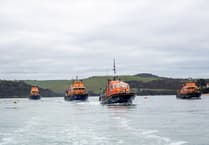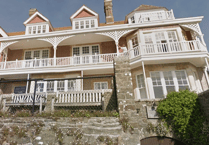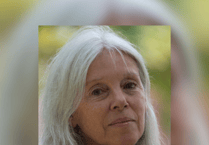The church was filled with singing, including Edward’s favourite hymns Will Your Anchor Hold and Guide Me O Thou Great Redeemer. As well as poignant tributes from his friends Frank Smith, Mike Wrigley, Malcolm Darch and Terry Andrews - a testament to Edward’s enormous regard in Salcombe and his contentment and fulfilment in his life there.
Edward, a master boatbuilder and former member of the Salcombe Lifeboat, made an enormous contribution to community life in the town, and was known by many as ‘Mr Salcombe.’
Edward was born on August 31, 1930 at 8 Robinson’s Row, Salcombe to William and Miriam Hannaford, née Patey. Through his parents, he could trace his family history back many generations in the local area. The sea ran through Edward’s veins and his family history.
Some of his ancestors were Huguenot refugees who were shipwrecked on Rickham Sands. His great-grandmother, Maria Patey sailed from Brixham with some of her furniture on a Brixham Trawler to marry her Salcombe husband. And Edward’s father was indentured on Brixham Trawlers at the age of sixteen.
Edward began his education at Salcombe Infant School at the age of five, already reading independently. He was an intelligent child, and gained a place at Kingsbridge Grammar School at the age of 11.
However desire to work with wood surpassed his desire to take a place there, so he began a five year apprenticeship at the age of fourteen, working towards becoming a master boatbuilder at Dornom’s yard, Whitestrand, Salcombe.
Edwards was nine at the outbreak of the Second World War, and had many interesting stories from that time, including the time he was shot at by a Luftwaffe aircraft as he rowed a boat towards South Pool, and later about the US armed forces based in Salcombe and the surrounding area while training for D-Day.
Edward was called up for National Service in 1951, and despite wishing to join the Navy, was landed in the Army. Given his experience, he served in the Royal Army Service Corps, Army Water Transport, based on the Isle of Wight and at the Royal Citadel in Plymouth - from which he managed to get back to Salcombe for many weekends, even walking the distance on one occasion.
Following National Service, Edward set up his own business hiring out small wooden rowing and motor boats from Whitestrand. He developed his own small fleet, buying one wooden boat at a time which he renovated beautifully and painted a distinctive turquoise.
He met his wife Sheila while she was on holiday with a friend in Salcombe, and Edward offered to tow them back to shore on their hired rowing boat. Marriage and two daughters followed.
Edward was noted locally for his expertise on the water and his ability to learn from a young age. He was taken off the street by the coxswain to serve as a bowman on the lifeboat crew at the age of 19, and was awarded his first RNLI jumper a couple of years later.
In 1962, as the RNLI station’s mechanic, Edward brought the Baltic Exchange, Salcombe’s new 47 foot virtually non-capsizeable lifeboat into Salcombe from the Isle of Wight.
He served the lifeboat for more than 30 years, as both a member of the crew and 2nd Coxswain/Mechanic, with 97 lives saved over those years. He also received an RNLI vellum award for saving five crewmen from a Belgian Trawler. Edward retired from the Lifeboat Service through ill health in 1981.
Edward served on the Salcombe Regatta committee for many years and was one of those instrumental in its continuing success. He also served the Salcombe Yacht Club as rear and vice commodore, declining the office of commodore when invited to take it.
Other great achievements included working for ten years restoring a 30 foot 1930s cabin cruiser, the Elsie Isabel, originally built by Skentleberry’s Yard in Plymouth. And being invited to meet the Duke of Edinburgh at a Buckingham Palace garden party on behalf of Salcombe Lifeboat Station.
Edward worked as a boatbuilder at number six and seven stores, Island Street - a business that continues today owned by Mike Wrigley, who had worked alongside him until Edward retired.
Edward also took great pleasure in his membership of the Salcombe History Society making many memorable contributions. He was also recorded in conversation by the late Harry Fulcher, with many wonderful and illuminating memories of Salcombe.
The new development in Island Street, ‘Hannaford’s Landing’ is named after Edward.
Father Daniel French said: ‘Edward was part of the furnishings of Salcombe, such a well-known, loved and generous character.
‘He was someone we all saw about town and has given so much of his life to this place in so many different ways. Particularly in his involvement with the lifeboat community.
‘Our best wishes and sympathies go to Sheila and the family.’




